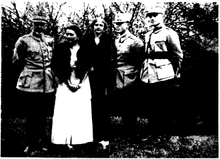
The Battle of the Vistula River, also known as the Battle of Warsaw and Ivangorod, was a major Russian victory against Germany and Austria-Hungary on the Eastern Front during the First World War.
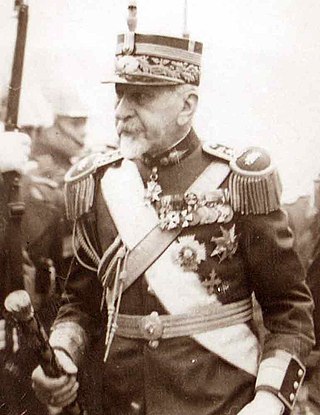
Constantin Prezan was a Romanian general during World War I. In 1930 he was given the honorary title of Marshal of Romania, as a recognition of his merits during his command of the Northern Army and of the General Staff.

The Kingdom of Romania was neutral for the first two years of World War I, entering on the side of the Allied powers from 27 August 1916 until Central Power occupation led to the Treaty of Bucharest in May 1918, before reentering the war on 10 November 1918. It had the most significant oil fields in Europe, and Germany eagerly bought its petroleum, as well as food exports.

The Battle of Prunaru was a military engagement between German and Romanian forces during the Romanian Campaign of World War I. It resulted in a tactical German victory, but following the heavy Romanian resistance the Germans halted after taking Prunaru. General Constantin Prezan's maneuver group checked the German forces in the region within two days, exposing the left flank of Field Marshal August von Mackensen's Danube Army.

The Battle of Bucharest, also known as the Argeş–Neajlov Defensive Operation in Romania, was the last battle of the Romanian Campaign of 1916 in World War I, in which the Central Powers' combatants, led by General Erich von Falkenhayn, occupied the Romanian capital and forced the Romanian Government, as well as the remnants of the Romanian Army to retreat to Moldavia and re-establish its capital at Iaşi.
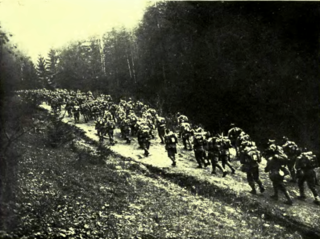
The Battle of Transylvania was the first major operation of Romania during World War I, beginning on 27 August 1916. It started as an attempt by the Romanian Army to seize Transylvania, and potentially knock Austria-Hungary out of the war. Although initially successful, the offensive was brought to a halt after Bulgaria's attack on Dobruja. Coupled with a successful German and Austro-Hungarian counterattack which started in mid-September, the Romanian Army was eventually forced to retreat back to the Carpathians by mid-October. The Romanian armies however managed to escape the Central Powers' attempts to completely destroy them. The Battle of Transylvania also caused the replacement of the chief of staff of the German Army and the shifting of German attention to the region, causing German offensive operations at Verdun to cease.
The Bulgarian Third Army was a Bulgarian field army during the Balkan Wars, World War I, and World War II.
The Battle of Robănești is a confrontation which took place between Romanian and German troops during the Romanian Campaign of World War I.

After a series of quick tactical victories on the numerically overpowered Austro-Hungarian forces in Transylvania, in the autumn of 1916, the Romanian Army suffered a series of devastating defeats, which forced the Romanian military and administration to withdraw to Western Moldavia, allowing the Central Powers to occupy two thirds of the national territory, including the state capital, Bucharest.

The First Battle of the Jiu Valley was a military engagement during World War I fought between Romanian forces on one side and Central Powers forces on the other. The German offensive, although initially successful, was checked within days and subsequently repulsed by a Romanian counterattack. This was the most conspicuous Romanian victory during the 1916 campaign, given that it was achieved against forces which were superior in artillery and - initially - in numbers as well.

The Second Battle of the Jiu Valley was a military engagement between German and Romanian forces during the Romanian Campaign of World War I. It lasted between 7 and 17 November 1916 and resulted in a German victory.

The Battle of Sălătrucu was a military engagement during the Romanian Campaign of World War I. It took place after the Battle of Transylvania and resulted in a Romanian victory. A mixed Central Powers force – under German leadership but with mostly Austro-Hungarian troops – conducted a failed offensive into Romanian territory, south of the Turnu Roșu Pass.
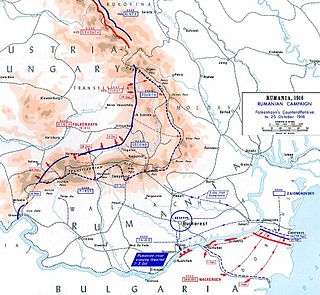
The Battle of the Southern Carpathians was a major operation during the Romanian Campaign of World War I. The brainchild of German General Erich von Falkenhayn, the operation consisted in an attempt by the Central Powers to assault all of the passes in the Southern Carpathians at the same time, and exploit a success wherever it might have come. However, this did not happen, as Romanian defenses could not be defeated in any of the five areas that Falkenhayn's spread-out army tried to force.

The Romanian Debacle consisted in a series of battles between November and December 1916 which led to the Central Powers conquest of Bucharest, the capital of Romania. Russian forces joined the Romanians at the start of December.

The Romanian campaign consisted in three battles between late July and early September 1917, fought between Germany and Austria-Hungary on one side versus Romania and Russia on the other. Romania emerged from this campaign with a slight net territorial gain and won its most important battle during the First World War.

The Pitești–Târgoviște Retreat was a fighting-withdrawal operation carried out by the Romanian 1st Army in the face of advancing Central Powers' forces during World War I. The retreat lasted from 29 November to 3 December and culminated in a violent battle at Târgoviște, after which the entire Romanian Army started a general retreat towards Moldavia.

The Veresmart Offensive was a World War I military engagement between Romanian forces on one side and Central Powers forces on the other side. It was part of the larger Battle of Transylvania. Although the Romanians failed to reach their planned objective, the strategic situation of the Central Powers was significantly worsened by the Romanian attack. Nevertheless, the Romanian forces did not exploit their strategic success further.

The Second Battle of Oituz was fought between 10 November and 16 November 1916. The Romanian forces, led by Brigadier-General Eremia Grigorescu, faced off against an Austro-Hungarian and German force led by Friedrich von Gerok. The battle resulted in the failure of the attempt by the Central Powers to force the Carpathian Mountains and enter the Siret valley in order to cut the Romanian forces in two.

The Battle of Nagyszeben was a World War I military engagement fought between the forces of the Central Powers on one side and the forces of Romania on the other side. It was the decisive engagement during the Battle of Transylvania, and also the largest, involving four armies out of the five fighting in the region: two Romanian, one German, and one Austro-Hungarian.
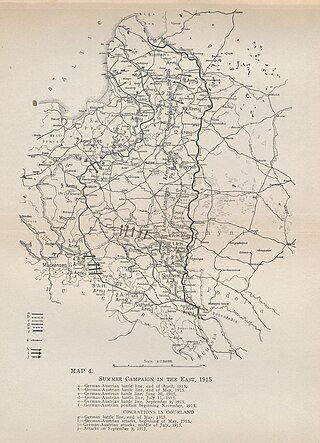
The Bug-Narew Offensive from July 13 to August 27, 1915 was a major German victory during World War I on the Eastern Front. The Imperial German Army broke through 4 heavily fortified positions, inflicted defeats on superior enemy forces and pushed the Russian Army 300 km to the east, capturing 215,000 prisoners. But the German army also suffered relatively heavy casualties, about 30,000 killed and missing.

